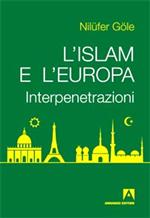 La traduzione italiana, uscita nella collana Modernità Postsecolare presso Armando Editore (2013). ISBN: 978-88-6677-102-9 (176 pagine)
La traduzione italiana, uscita nella collana Modernità Postsecolare presso Armando Editore (2013). ISBN: 978-88-6677-102-9 (176 pagine)
![]() Esiste un conflitto tra le religioni? Tra le civiltà? E se esiste, può essere giustificato dall’antagonismo tra un Occidente ancorato alla modernità e alla laicità, e un Islam congelato nella fede e nella tradizione? A partire dagli attentati dell’11 settembre, il testo analizza la natura profonda dei loro autori e la complessità dei loro rapporti con l’Occidente. Invitando il lettore a fare un’opportuna distinzione tra Islam e islamismo, e mettendo l’accento sulla grande disomogeneità dell’Islam contemporaneo, l’Autrice analizza il problema prendendo ad esempio la Turchia dei nostri giorni.”
Esiste un conflitto tra le religioni? Tra le civiltà? E se esiste, può essere giustificato dall’antagonismo tra un Occidente ancorato alla modernità e alla laicità, e un Islam congelato nella fede e nella tradizione? A partire dagli attentati dell’11 settembre, il testo analizza la natura profonda dei loro autori e la complessità dei loro rapporti con l’Occidente. Invitando il lettore a fare un’opportuna distinzione tra Islam e islamismo, e mettendo l’accento sulla grande disomogeneità dell’Islam contemporaneo, l’Autrice analizza il problema prendendo ad esempio la Turchia dei nostri giorni.”
 Following the Arab Spring and the regime changes in Tunisia, Lybia, and Egypt, Western observers were puzzled by the seemingly counter-intuitive outcome of those “revolutions”: popular mobilization led by young, secular, marginalized elites, paving the way for Islamist power and further unrest, as if the open opportunity for democratization had given birth to an unwanted child. How could this outcome be reconciled with widespread visions of modernity? Is the new Islamist power anti-modern, or rather further evidence that modernity has become plural, fragmented, multiple in the wake of globalization and new pressures that come from emerging societies?
Following the Arab Spring and the regime changes in Tunisia, Lybia, and Egypt, Western observers were puzzled by the seemingly counter-intuitive outcome of those “revolutions”: popular mobilization led by young, secular, marginalized elites, paving the way for Islamist power and further unrest, as if the open opportunity for democratization had given birth to an unwanted child. How could this outcome be reconciled with widespread visions of modernity? Is the new Islamist power anti-modern, or rather further evidence that modernity has become plural, fragmented, multiple in the wake of globalization and new pressures that come from emerging societies?
In the third book in our series, Nilufer Gole writes from the vantage point of being an intellectual coming from a country – Turkey – at the center of contemporary debates about the modernization of Islam and the very existence of an Islamic pathway to modernity. To the eyes of the West – a constructed “self” naturalized in the relation to its “other”, Islam – modernization involves mostly secularization and political moderation, as witnessed in many post-9/11 debates. Gole, on the contrary, is more interested in defining the peculiar traits of Islamic modernity as a process that is embedded in the fragmentation of the idea of modernity itself, affected by global, glocal, and local dynamics.
The encounter between Islam and modernity has brought mutual transformations in the context of a dialectic of proximity and distance. Islam is perceived at the same time as close and visible – in its exterior signifiers like mosques, minarets, and veils, as well as in its hyper-modern attacks on constructed ideas of the “West” – and distant, as the negation of the West, an object of domination and not the subject of synthesis in the framework of modernity.
Gole argues that contemporary Islam has become co-existent with the cultural and social experience of Europe, because they take part and act in the same public spaces of modernity. They share the same space of contemporaneity, in which Islam strives for its own way to modernity, in contrast both with the project of European secular modernity and the old attempts to modernize Islamic countries through modernization from above, a replication of the European vision which ¬– through the separation of religion and the state – put at the center the notions of secularism and laicité.
Islamic modernity, which cannot be reduced to Islamist political actors, exerts its pressures from the margins, from territories that had been exposed to modernity from above by elites in the process of formation of the nation-state, or which had gone through the experience of colonialism. The new Islamic modernity, which becomes increasingly visible in the European public sphere as well as in the resurgence of political Islam and even in the more extreme instances of terrorism, is global, enhanced by movements of people, images, and signifiers of Islam that look for a dialogic position both in European public spaces and extra-European contexts.
Gole focuses on these signifiers, these markers of political and religious visibility, as proxys of Islam’s presence and openness for dialogue as a much needed condition for the mutual construction of identity. The experience of women in Islam, the redrawing of urban landscape, and even snapshots of terrorism all serve to put forward the analysis of one of the most compelling issues in contemporary Europe and Islamic societies alike: what, if there is any, is the nature of the exchange between identities, and what collectivities can gain from the recognition of plural attitudes to “being modern”?